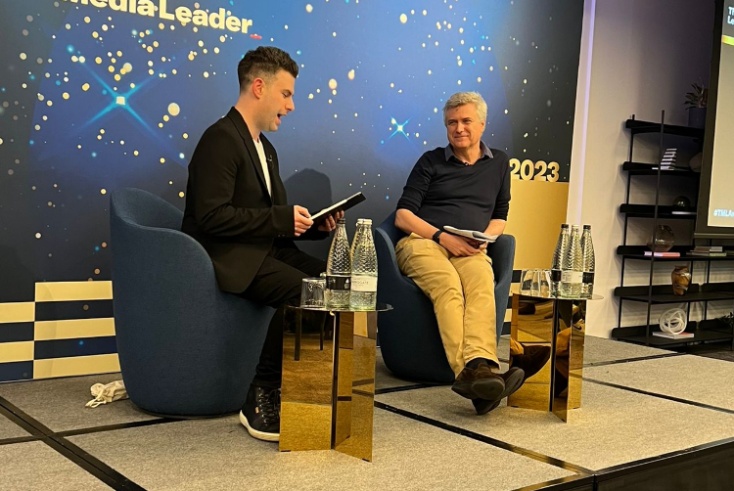WPP CEO Mark Read: ‘I wouldn’t be here now if it were not for Jeremy Bullmore’

WPP’s CEO Mark Read said he would not be where he is in his career without the influence of Jeremy Bullmore, who was given a special posthumous award by The Media Leader for his outstanding contribution to advertising.
At The Media Leaders Awards ceremony in London yesterday, Read had a fireside chat with editor Omar Oakes about the legacy of the winner of the Judges’ Special Choice Award, Jeremy Bullmore who died in January aged 93.
Read said to the audience that anyone who knew Bullmore would say he would be “mortified” and “very embarrassed” to receive an award and would maybe refuse to turn up to collect it if he could, and really rather not have won it at all.
Bullmore was dubbed “adlander’s greatest philosopher” and worked his way from trainee copywriter at J Walter Thompson in 1954 to chairman in 1976 before “retiring” in 1987 following the company’s acquisition by WPP.
Read revealed how he never actually retired and until the Covid pandemic would come into the WPP Sea Containers’ office on the eleventh floor Monday to Thursday. A difficult conversation for Read was to ask Bullmore to stop coming into the office for his safety when the pandemic started, and unfortunately he never got to come back again.
He told the audience that at the start of his own career in 1989 he was working in “a funny little building” on Farm Street where his office was at the back of the building and Bullmore’s was at the front by the boardroom (incidentally the only place where David Frost was allowed to smoke cigars at the time).
He revealed: “If you were bored, and I had quite a low boredom threshold, you could always go to chat to Jeremy for a bit. And I often, probably most days, went and spent an hour, an hour and a half in his office talking about the business, about advertising, about how to run pitches and we talked about some of the examples.”
Read added: “[Bullmore] had an immense amount of time for a large number of people, some of whom are important, some of whom like me at the time were extremely unimportant. He liked people and sometimes found them a little bit irritating, and when he found you irritating he certainly told you.
“He would impart wisdom to an enormous number of people and he would give people time to come and knock on his door and he would like to spend time in the office.”
Read said Bullmore would approach problems with “a large degree of common sense” and in a straightforward way with practical examples. For instance, when he started at JWT in the 60s when telephones were starting to be brought inside offices, new graduates were not allowed a telephone for the first six months which would force them to go around the building, meet people and make things happen. A potential parallel to today would be new starters not using email for the first six months of their jobs.
On pitching, Read said Bullmore advised that if you want to win a pitch then you would need to think of a client’s problem and three things the client has, and then think of three really concrete pieces of work the agency has done that answers the client’s question so they have not only a reason to believe you but evidence that you can solve the problem they have asked.
Some of the work Bullmore is most known for is inventing the brand Mr Kipling’s Cakes, when Rank Hovis McDougall came to JWT with a problem of having too much flour and not knowing what to do with it. JWT devised the name, logo, design, packaging, advertising, and they even had a food design kitchen to test the recipe.
Read said this was reflective of what a full-service agency helping brands solve problems could do, which was a constant in the 60s, but that over the history of the industry this has since become more fragmented with clients now having 20 or 30 agencies as the ability to solve holistic problem for clients has been eroded.
Bullmore was also known for his three agony uncle columns — first for Management Today, then Campaign and, finally, The Guardian.
In terms of advice for the next generation of the industry, Read said: “I think he’d advise people to get to know clients, to be curious, to go out in the world and see what’s going on and how these ideas can be taken to clients. I think he’d advise people to be back in the office a bit more often and be visible and be present because if you’re hidden away, however talented you are, no one’s going to be able to see that [working remotely].”
Another recommendation he thinks Bullmore would have made is to spend as much time with clients as ultimately they pay the bills and understanding what they need and how to help them succeed is the most important.
Read finished the session by reading out a memo written by Bullmore entitled “10 tried and tested ways to piss of clients”, much to the laughter of the audience with tips including taking 11 of your side to every client meeting, ensure the only person your client has contact with is your voicemail, and when flying with a client, make sure they are comfortably settled in economy before going to the front yourself.
There is now a website with more about Jeremy Bullmore’s life and work which WPP has created here.




